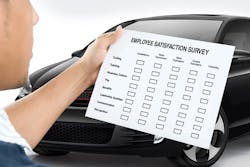Golden State Collision Centers had a sky-high 30 percent employee turnover rate in 2007, which led to productivity losses and additional costs to train new employees. Tackling that costly problem ranked high on Jill Meeuwsen’s to-do list when she took over as director of operations that year for the five-shop operation in Sacramento, Calif.
Meeuwsen knew she wouldn’t be able to improve the company’s turnover rate until she uncovered the cause. Worker satisfaction and their longevity at a business correlate directly, she says, so she hired Phoenix Solutions Group to do a check-up. The collision industry marketing and customer research firm conducted an employee satisfaction survey to identify problems the business was having—from an employee perspective.
issues with shop employees,”
—Tina Biancalana, vice president of operations,
Phoenix Solutions Group
The survey asked employees about all aspects of business: tooling, training, business culture, pay, benefits, leadership qualities, communication and recognition.
Meeuwsen says she was prepared to hear about some problems, and pinpoint areas to improve the business. And she did. The survey revealed only a 70 percent employee satisfaction rate in one of the company’s locations. Employees’ biggest area of concern was recognition—they wanted more of it.
Golden State’s leadership team implemented a few tactics to accomplish that, Meeuwsen says. The company launched a newsletter to help recognize employees for good performance. They began recognizing employee birthdays and anniversaries, as well.
Recognition tactics don’t have to be groundbreaking to make a difference. Golden State’s approach showed that the company listened to employee concerns, and that an attempt was made to address them, Meeuwsen says. Employee satisfaction jumped significantly, to 85 percent, and turnover dropped 6 percent after the simple improvement was made.
Uncover the Problems, or Your Customers Will
Employee satisfaction is no less important than customer satisfaction, says Tina Biancalana, vice president of operations at Phoenix Solutions Group. Most shop operators feel they do great work and customers love them. But customer service indexing (CSI) results show that’s not always the case.
Many times, the same story plays out with staff.
“Owners are often a bit removed from their employees,” Biancalana says. “There can be a lot of disconnect between how owners think their employees feel and how they actually feel.”
Only 52 percent of workers are satisfied with their job, according to a 2010 U.S. employee satisfaction survey conducted by the Hay Group, an employee performance and motivation consulting firm. The study, says Joyce Gioia, president and CEO of the Herman Group, an employee retention and organizational development consulting firm, uncovered the most common reasons for employee dissatisfaction:
• Poor business culture
• Lack of employee appreciation
• Lack of leadership support
• No opportunities to learn new skills to enhance the employee’s career
• Dislike of the supervisor
• Poor or unfair wages
Determining whether your employees fall into the 48 percent of happy employees or the 52 percent of unhappy ones is critical, Gioia says. Unhappy workers can have a dramatic negative effect on your business. They can infect other employees with their negative thinking, and customers will take notice.
“Customer satisfaction levels always drop when there are issues with shop employees,” Biancalana says. “Customer communication isn’t as strong and courtesy levels drop.”
Given the differences in perception between employers and their staff, it’s impossible to determine how to resolve the issues that trouble employees without some kind of inside information. “You’ll never know what’s going on in the hearts and minds of your workers if you’re not doing some kind of employee satisfaction survey,” Gioia says. “It’s a vehicle for your employees’ voices to be heard, and to have an opportunity to create positive change for the business.”
A Successful Survey
The success of your employee satisfaction survey greatly depends on how it’s deployed, Biancalana says. Employees have to know why their feedback is important, and how it will be used in their favor.
A few considerations will ensure you obtain maximum value from the survey—and that employees will take it seriously:
• Make it anonymous. Anonymity helps employees feel comfortable about speaking their mind openly, which results in more honest and helpful feedback.
• Use a third party. Employees perceive the surveys to be more credible when a third party is used, rather than when employers create a list of questions on their own, Biancalana says. Employees also feel more comfortable about retaining anonymity.
It’s not terribly expensive to hire a company to help you with this. Biancalana says Phoenix Solutions Group charges about $35 per survey per employee. There are many organizations that can help you with this.
• Make employees feel comfortable. Ensure your employees that there won’t be any negative backlash for providing honest feedback and opinions, Biancalana says. She suggests using the following phrase to introduce this to your employees: “We understand there are some challenges everybody is dealing with here. We are ready to make changes, but we need your honest feedback to do so.”
• Allow work time to participate. Employees often don’t complete the survey when they’re asked to do it on their own time, Biancalana says. It only takes about 20 minutes to fill out, so offer some time at work to do it.
• Act on the feedback. The survey loses its purpose if you don’t do anything with the feedback. Implement changes immediately after receiving the results.
“Employees tend to be very supportive of the survey process when they actually see that it leads to improvements,” Biancalana says. “It improves their morale and motivation to see that their opinion actually makes a difference.”
• Discuss survey results with employees. Hold an employee meeting to openly discuss the feedback that was given, Gioia says. That discussion will allow employees and management to get on the same page. It can also be used as a forum for employees to offer suggestions to improve.
Your employees might express dissatisfaction in the survey over something you’re not able to change, Biancalana says. It’s important to be honest, and explain why certain changes aren’t possible.
• Survey your team regularly. Meeuwsen conducts satisfaction surveys twice a year—every six months to avoid overlooking an issue that needs attention.
Gioia suggests doing a survey after big changes happen in the shop—like a management change—to gauge how employees feel about it.
If your employee satisfaction survey spurred you to make a change in the shop, conduct a follow-up survey to identify how employees embraced those changes, Gioia says. She says shop owners should wait at least three months after changes are made to conduct follow-up surveys.
Employee Happiness Improves Business Performance
The purpose of conducting employee satisfaction surveys isn’t just to make employees feel good; it’s to highlight weak areas of your business that you can improve. Employees often have a lot of good ideas on how to do so. But you need a tactic to tap into those ideas. Satisfaction surveys can act as a catalyst to spur more open communication between staff and management.
“Everything centers around communication,” Biancalana says. “If you interact with employees on a regular basis, they sense an open environment, and are more likely to bring issues to your attention before you even ask.”
Meeuwsen can attest to that. After conducting only one satisfaction survey—and implementing some employee recognition strategies to address the feedback—employees knew that management was listening to them, and taking action. They quickly became comfortable speaking openly about workplace challenges during meetings—something they hadn’t done before the survey.
“The survey fostered a lot more open communication throughout our entire company,” Meeuwsen says. “It’s changed the level of trust employees have with management.”
The 10% Productivity Boost
Employee satisfaction boosts overall business performance, Gioia says. That 2010 Hay Group study that reported more than half of employees are unhappy? It also revealed that businesses with high employee satisfaction increase productivity by 10 percent, reduce turnover by 40 percent and increase customer satisfaction by 71 percent.
Meeuwsen says she’s noticed all of those benefits, and more: improved repair quality, greater employee motivation and fewer sick calls.
Those improvements add dollars to your bottom line, Gioia says. Business owners just have to be committed to improving their employee’s work environment for that to happen.
You’re going to deal with myriad issues every day if you don’t do anything to address employee concerns, Meeuwsen says.
“You can look at problems as a cost of doing business, or you can find out the cause of those problems,” Meeuwsen says.
Do the latter, she says, and you’ll have a silver bullet for ending employee unhappiness.



